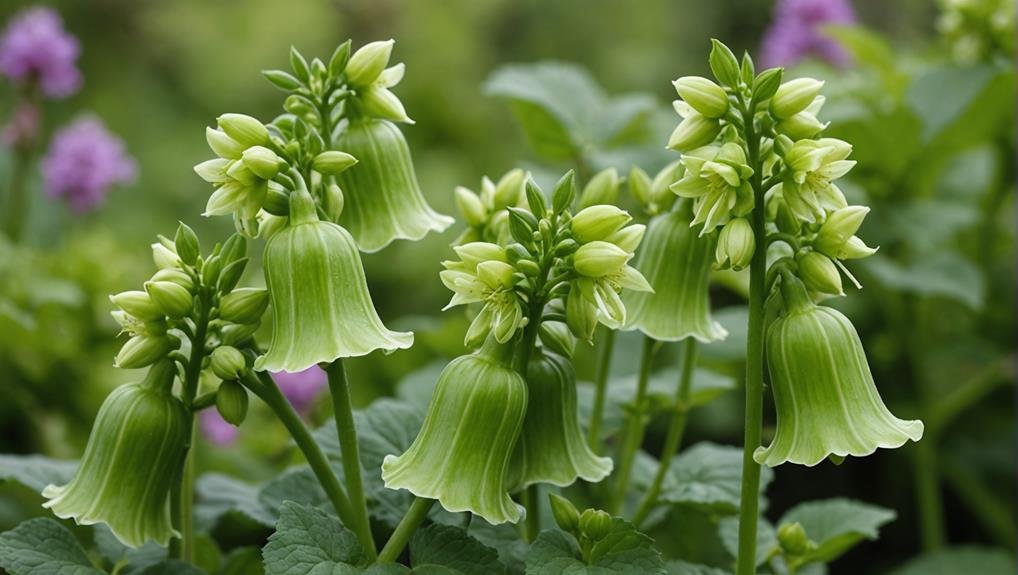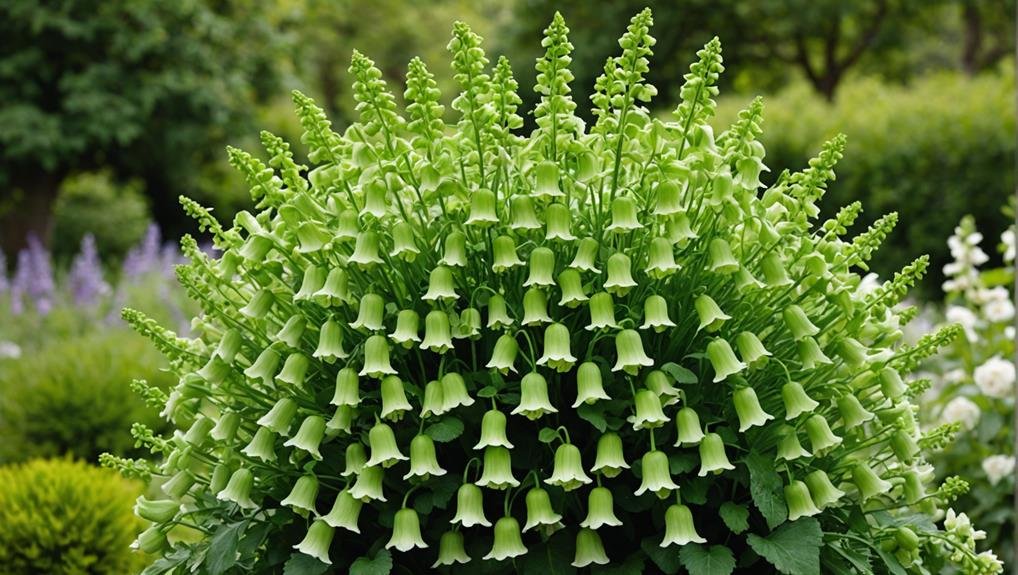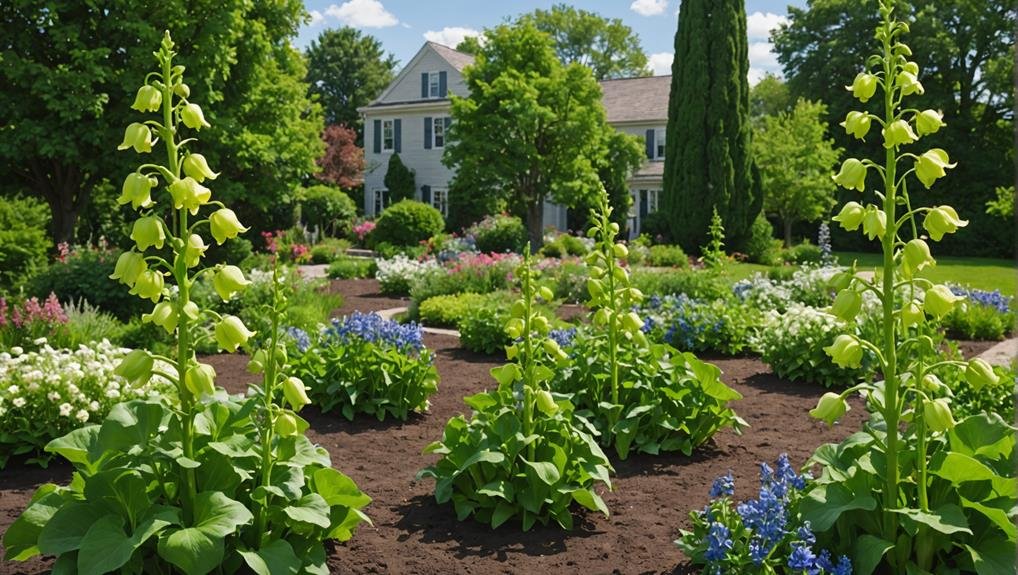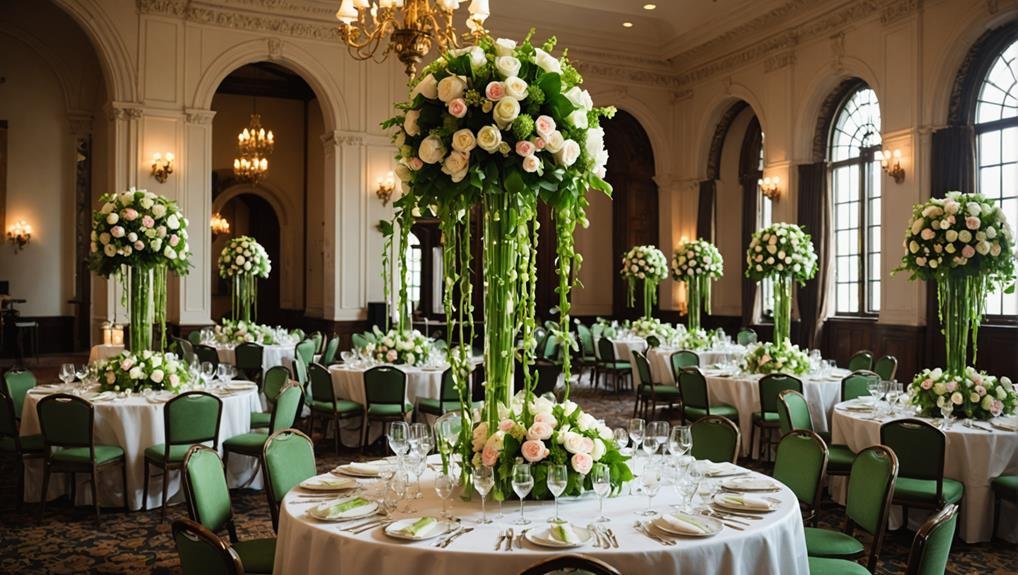When selecting flowers for wedding decor, Bells of Ireland offer a distinctive option, renowned for their elegant green hues and symbolic representation of fortune and growth. These striking flowers, featuring elongated stems and bell-shaped blooms, bring a sophisticated touch to any arrangement. Their unique texture and vibrant color make them versatile components in bouquets and centerpieces, harmonizing seamlessly with a variety of floral designs. To truly appreciate how these flowers can elevate your wedding aesthetics and imbue your event with deeper meaning, it is essential to explore their characteristics, origins, and best uses in detail.
Flower Overview

Bells of Ireland, scientifically identified as Molucella, are distinctive flowers native to Turkey and Syria, belonging to the mint family. These flowers are particularly renowned for their striking appearance and versatility in floral arrangements, especially tall arrangements. Their long stems, adorned with bell-shaped green petals encircling tiny white flowers, make them an excellent choice for creating visually dynamic and elegant displays.
Bells of Ireland are highly favored in wedding floral designs due to their unique shape and height. Their stems, which can range from 60cm to 100cm in length, lend themselves perfectly to tall arrangements that add a sense of grandeur and sophistication to wedding venues. The greenery provided by Bells of Ireland pairs harmoniously with other popular wedding flowers such as stock and snapdragons, enhancing the overall aesthetic with their distinctive form and vibrant green hue.
Moreover, these flowers are not only visually appealing but also carry symbolic meaning, being traditionally associated with good luck. Brides and florists alike appreciate the combination of beauty and symbolism that Bells of Ireland bring to wedding arrangements. For those seeking to purchase them, wholesale options are available online, ensuring accessibility for large-scale events.
Physical Description
With their unmistakable aesthetic, the physical characteristics of Bells of Ireland contribute greatly to their popularity in wedding floral designs. Known scientifically as Molucella, these flowers are distinguished by their unique structure, featuring tiny white flowers encompassed by bell-shaped green petals. This combination creates an elegant and visually striking appearance, perfect for sophisticated floral arrangements.
The flowers grow along a single, slender stem, which can vary in length from 60cm to 100cm. This range of stem lengths makes Bells of Ireland exceptionally versatile, allowing them to be incorporated into a diverse array of wedding bouquets, centerpieces, and other decorative floral displays.
Typically sold in wraps of 10 stems, they are readily available as cut flowers in wholesale markets, ensuring that floral designers have easy access to these sought-after blooms.
Aside from their aesthetic appeal, Bells of Ireland are also favored for their symbolic meaning. Often associated with good luck, they add an extra layer of significance to wedding decor, making them an ideal choice for couples looking to infuse their special day with both beauty and auspicious symbolism.
Their lush green hue and unique form make them a staple in the domain of wedding flowers.
Available Colour Varieties

Although primarily known for their vibrant green hue, Bells of Ireland occasionally exhibit slight variations in color intensity and undertones. This inherent variability can add a unique dimension to floral arrangements, making them a versatile choice for both traditional and contemporary wedding decor. The green hue of Bells of Ireland not only enhances the natural beauty of bouquets but also symbolizes luck, making it a popular choice for special events.
To provide a clearer picture of the color variations, here is a table that outlines the subtle differences you might encounter:
| Color Variation | Description |
|---|---|
| Vibrant Green | The most common and sought-after shade, rich and lively. |
| Light Green | A softer variant, offering a delicate and invigorating appearance. |
| Dark Green | A deeper hue, providing a more dramatic and bold look. |
| Green with White Undertones | Exhibits a slight white tinge, adding an elegant contrast. |
The primary green hue of Bells of Ireland is universally appreciated for its invigorating, natural touch. These subtle variations in color intensity and undertones enhance the flower's versatility, allowing it to seamlessly blend into an array of floral arrangements, from the simplest bouquets to the most elaborate centerpieces.
Latin Name and Taxonomy
Molucella laevis, commonly known as Bells of Ireland, belongs to the mint family Lamiaceae. This classification places it among a diverse group of aromatic plants, many of which are widely used in culinary and ornamental applications.
The Latin name, Molucella laevis, provides a scientific reference that guarantees precise identification and classification within the botanical community. Despite its common name suggesting an Irish origin, Bells of Ireland actually hails from regions such as Turkey and Syria.
In taxonomy, Molucella laevis is categorized under the genus Molucella, which comprises a small number of species known for their unique floral structures. The specific epithet 'laevis' denotes the smooth texture of the plant's stems and leaves, distinguishing it from other members of the Lamiaceae family.
The plant's distinctive bell-shaped green calyces, which encase tiny white flowers, add to its taxonomic uniqueness and aesthetic appeal.
Understanding the Latin name and taxonomy of Bells of Ireland is essential for florists and horticulturists, enabling effective communication and accurate identification. This foundational knowledge guarantees that the plant is correctly utilized in floral arrangements, particularly in weddings where its symbolism of good luck is highly valued.
Geographical Origins

Understanding the geographical origins of Bells of Ireland reveals their fascinating journey from the areas of Turkey, Syria, and the Caucasus to their prominent role in modern floral arrangements. Despite their name, Bells of Ireland, also known as Molucella, are not native to Ireland. Their true roots lie in the temperate climates of the Eastern Mediterranean and the Caucasus, where they thrive in rocky and well-drained soils.
These regions, with their blend of mild winters and warm summers, provide the ideal growing conditions for Bells of Ireland. The plant's ability to adapt to various climates has contributed to its widespread cultivation and popularity across different parts of the world. This adaptability is essential, especially for florists and gardeners who seek to incorporate this unique flower into their designs.
To emphasize the key points about their geographical origins:
- Native Regions: Turkey, Syria, and the Caucasus.
- Climate Preferences: Mild winters and warm summers.
- Soil Type: Rocky and well-drained soils.
- Adaptability: Able to thrive in various climates, aiding widespread cultivation.
Understanding these geographical origins underscores the resilience and versatility of Bells of Ireland, making them a beloved choice in floral arrangements for various occasions.
Season Availability
Bells of Ireland are available year-round, making them a versatile and dependable choice for wedding floral arrangements regardless of the season. Their consistent season availability guarantees that couples can enjoy these elegant flowers whether they are planning a spring, summer, fall, or winter wedding.
Thriving particularly well during the spring and summer months, Bells of Ireland naturally align with the peak wedding season. This seasonal flourishing contributes to their popularity during these times, providing lush and vibrant green accents that complement a wide range of floral designs.
However, their availability does not diminish as the colder months approach. In fact, Bells of Ireland can be found during the fall and winter months as well, securing that couples have access to quality blooms for their wedding arrangements throughout the entire year.
This year-round availability allows for creative and diverse floral designs, catering to various wedding themes and settings. Whether used as a focal point or an accent, Bells of Ireland offer consistent quality, ensuring that florists and couples can depend on them to enhance the beauty of wedding arrangements.
This dependability makes Bells of Ireland a steadfast choice for any wedding season, providing elegance and charm to floral displays.
Growing Conditions

To foster the flourishing of Bells of Ireland in wedding arrangements begins with comprehending their prime growing conditions. These remarkable flowers, recognized for their lively green bells and robust stems, prosper under specific environmental setups. Here are the fundamental growing conditions to ponder for cultivating Bells of Ireland:
- Sunlight: Bells of Ireland necessitate full sun to partial shade to grow at their best. Strive to plant them in a spot that receives at least six hours of direct sunlight daily.
- Soil: These flowers favor well-drained soil. Ensuring adequate drainage will help prevent root rot and other moisture-related issues, promoting healthier plants.
- Watering: While Bells of Ireland are drought-tolerant once established, regular watering during their initial growth stages is vital. This aids in the proper development of roots, leading to sturdier and more resilient plants.
- Planting Time: Bells of Ireland are annual plants that should be planted in the spring after the threat of the last frost has passed. This timing guarantees they have the entire growing season to mature and bloom.
Adhering to these growing conditions will help guarantee that Bells of Ireland not only thrive in your garden but also make for striking additions to wedding floral arrangements.
Cultural Significance
The cultural importance of Bells of Ireland is deeply rooted in their symbolic representation of good luck and prosperity, making them a favored choice for weddings and celebratory events. Traditionally, these flowers have been revered for their association with good fortune. In the language of flowers, Bells of Ireland are emblematic of luck and wealth, which explains their popularity in ceremonies and festivities that mark new beginnings.
Interestingly, despite their name, Bells of Ireland are not native to Ireland. They originate from regions such as Turkey, Syria, and the Caucasus. Nonetheless, their distinctive, bell-shaped green petals, which house small white flowers, have captured the imagination of many cultures, including the Victorians. During the Victorian era, these flowers were particularly cherished for their symbolic meanings of good fortune and prosperity.
Part of the mint family, Bells of Ireland are unique not only in their appearance but also in their cultural symbolism. Their lush, green hue naturally evokes images of exuberance and growth, further enhancing their association with positive outcomes.
This rich cultural context underlines why Bells of Ireland continue to be a popular choice for those seeking to incorporate elements of good luck into their special occasions.
Typical Use in Weddings

Given their rich cultural significance and symbolic representation of good luck, it's no surprise that Bells of Ireland are commonly used in various aspects of wedding decor. These elegant cut flowers are a popular choice for their ability to add both height and a touch of greenery to floral arrangements, making them a versatile option for numerous wedding settings.
Bells of Ireland can be seamlessly integrated into a variety of wedding decor elements, including:
- Bridal Bouquets: Their tall, green stalks provide a striking contrast to colorful blooms, making the bouquet both eye-catching and meaningful.
- Centerpieces: Used in centerpieces, Bells of Ireland add vertical interest and a lush, garden-like feel to reception tables.
- Ceremony Arrangements: These flowers can frame the aisle or altar, creating a natural and elegant backdrop for the wedding ceremony.
- Complementary Arrangements: Bells of Ireland pair well with a range of flowers, enhancing both traditional and modern themes with their unique appearance.
Their robust nature and visual appeal make Bells of Ireland an excellent choice for couples seeking to incorporate good luck and sophistication into their wedding decor. Whether used in a grand arrangement or a subtle accent, these cut flowers deliver a distinctive and memorable touch.
Alternative Flower Types
While Bells of Ireland offer a unique and elegant touch to wedding decor, several alternative flower types can provide similar aesthetic appeal and versatility. For instance, snapdragons are an excellent substitute, bringing a comparable tall and graceful aspect to floral arrangements. These flowers are known for their striking vertical presence and come in a variety of colors, making them a versatile choice.
Stock flowers also make a compelling alternative to Bells of Ireland. They add a fragrant and colorful dimension to wedding bouquets, with their clusters of blossoms available in hues ranging from white to rich purple. Another notable option is delphiniums, which feature tall, spiky blooms in shades of blue, pink, and white, offering both height and visual interest.
Lisianthus flowers present another delicate alternative, resembling roses with their soft, petal-filled blooms. They come in various colors, including white, pink, and purple, making them a versatile addition to any wedding theme. To add a more exotic and tropical touch, red ginger flowers can be considered, with their vibrant red spikes making a bold statement.
Here is a comparison of these alternative flower types:
| Flower Type | Characteristics | Color Options |
|---|---|---|
| Snapdragons | Tall, elegant | Various |
| Stock | Fragrant, colorful | White, purple, etc. |
| Delphiniums | Tall, spiky | Blue, pink, white |
| Lisianthus | Delicate, rose-like | White, pink, purple |
| Red Ginger | Tropical, vibrant | Red |
These alternative flower types offer a range of options to suit different wedding styles and preferences.
